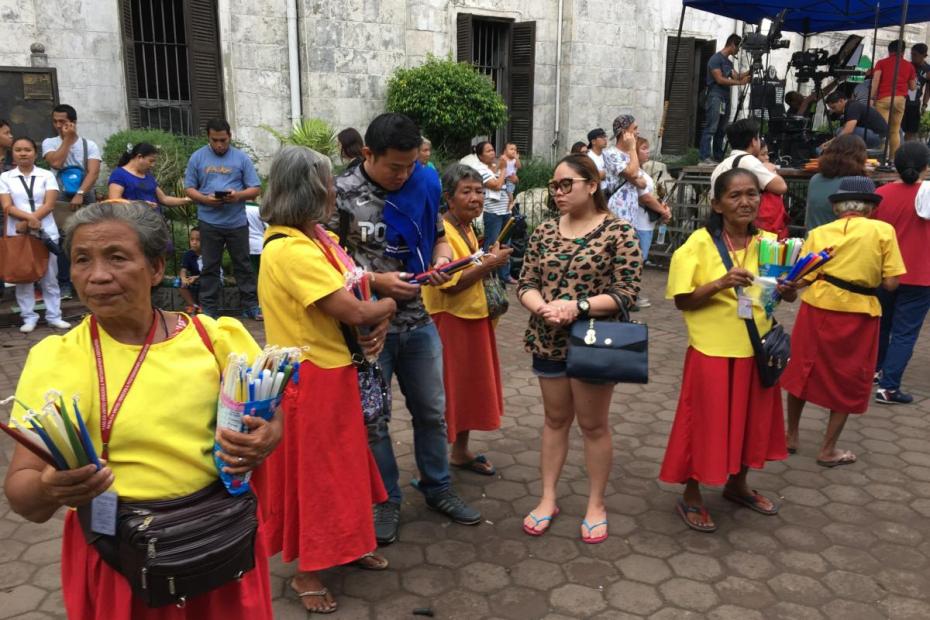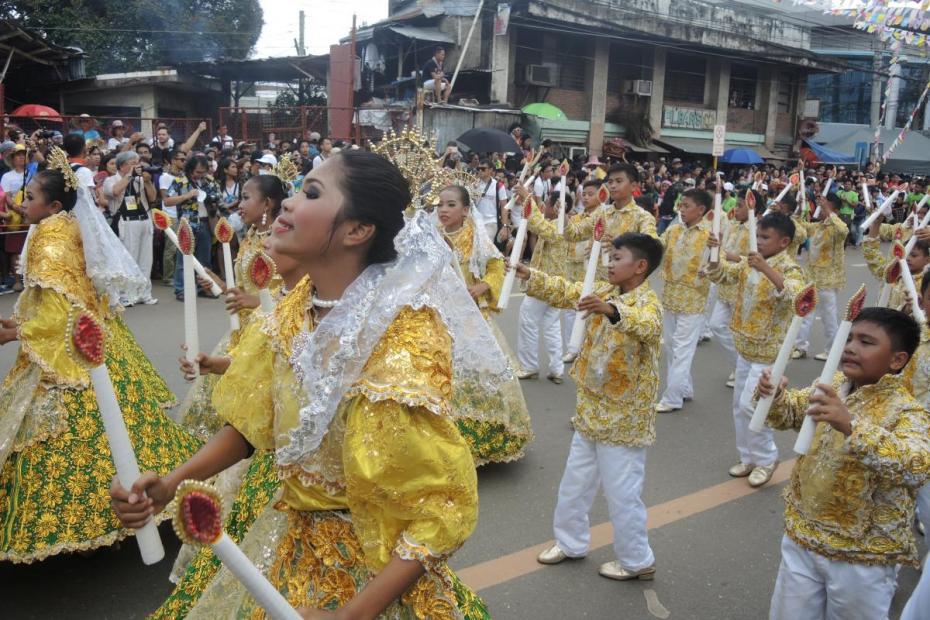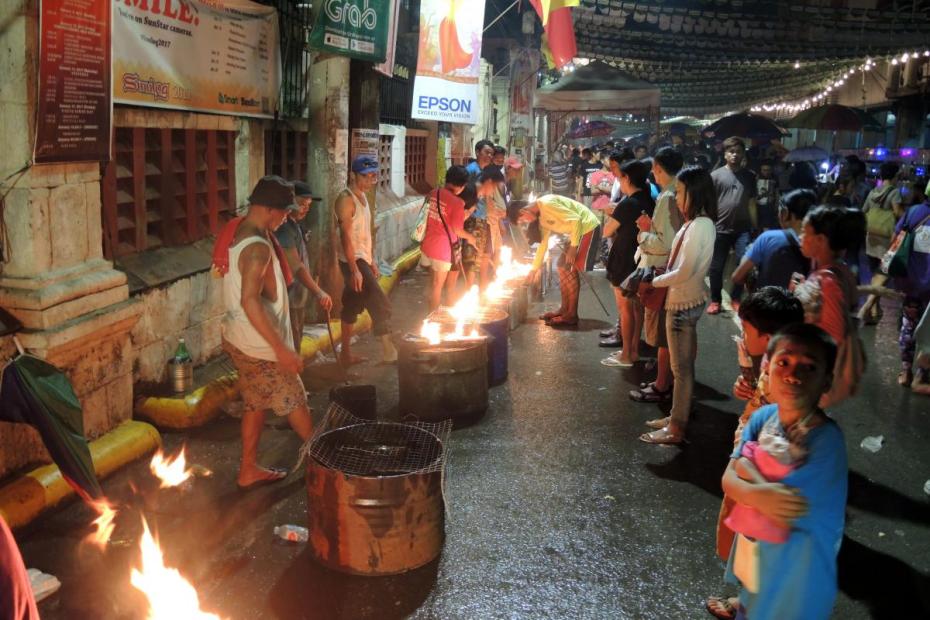Just outside the doors of the Basilica of the Santo Niño in Cebu, a dozen or two older women act as trusted, surrogate pray-ers for devotees who come to bring their prayers to the Santo Niño. Like generations of women before them, tig sinulog sell candles for a small sum, and use the candles, sinulog dance steps, and spoken word to offer prayers for whatever cause they are asked to pray for. Sinulog is two-step-forward, one-step-back dance step that is believed to predate Christianity and to take its name from Cebuano word for the way water laps on the river.
Amidst the sea of people at masses in the plaza, in front of the image of the Santo Niño in the basilica, and outside the plaza gates, the activity of 15-20 older women in yellow blouses and red skirts might seem insignificant. Nonetheless, they are understood as a powerful link to Cebuano history and as helpful intercessors. Their dance, the sinulog, is the dance that gives the contemporary multi-week festival for Santo Niño its name.1
Tig sinulog are women who sell candles outside the Basilica of the Santo Niño in Cebu, and offer to pray, through spoken word and dance, for people who request them.
These women are present year-round outside the doors of the basilica church, and are often the second or third generation in their family to carry out this role. The women were long an informal part of Catholic life at the basilica, but in recent decades their role has been somewhat more institutionalized and better protected. Only women approved for the role are allowed to fulfill it in the church grounds, though many others set up stands at night outside to sell candles and offer prayers. Tig sinulog women belong to an independent association guided by the tourist board and the church, and even carry ID cards. An interviewee who knows many of the women said that they have to learn how to pray, “and to pray by heart,” and had to be proven trustworthy so that any devotee could share any petitions. They could be single or married, but they were typically the daughters of prior members.
Tig sinulog women sell candles, but their purpose is more significant. With each sale they offer prayers that are not supposed, technically, to be part of the commercial transaction. Through dance and word, the women offer prayers of thanksgiving to the Santo Niño, make requests to him on behalf of petitioners, or relate a devotee’s vow. Sally Ann Ness, who conducted extensive fieldwork with the women in the 1980s, notes that in her many observations, the sinulog dance was never performed for the dead. It was a “rite for the living, a means of coping with day-to-day events and circumstances.”2
After the prayers, the devotees who buy the candles take them outside of the church and the plaza gates, and usually leave them unburned at Magellan’s cross, or burn them in improvised grates in the street.
The Sinulog parade has refocused attention on the dance element of their prayer, though it was always part of their role. In her interviews with tinderas in the mid-1980s, Ness noted that until the Sinulog parade became a big event, the vast majority of people who came to them asked for candles and a prayer, but that increasingly after that, people asked for a sinulog dance at the same time, until it was what everybody wanted.3
Ness saw them, as one still can today, take on the roles of “the spirit medium, the benign counselor, the friend, the grandmother, the servant, the withdrawn laborer.”4 Oftentimes, during the Sinulog feast in 2017, the women’s movements, especially foot movement, were so limited as to make their action barely seem to count as dance. This could be because most encounters were late in the day and women were weary. Ness also writes that upon first encountering the women’s sinulog dance, she “questioned whether the or not the behavior really merited the label of ‘dance.’” She “found it hard to believe that this was the ritual that was once said to have been the climax of the yearly Santo Niño Fiesta, when pilgrims would perform it en masse inside the basilica on procession day. It was equally difficult to understand why this dance had become the inspiration for the city’s Santo Niño festival promotion and a central symbol of Cebuano regional pride.” On the other hand, she noted, despite many signs and local perceptions that the tindera sinulog was simply a commercialized form of the ritual, other Cebuanos saw as “the only ‘real’ version of the sinulog dance” the one that was that done by these women at the basilica.5
Read more
Sally Ann Ness, Body, Movement and Culture: Kinesthetic and Visual Symbolism in a Philippine Community (Philadelphia: University of Pennsylvania, 1992).
- 1Sally Ann Ness, a dance scholar and anthropologist who conducted intensive fieldwork with these women in the 1980s, notes that the origin of the Sinulog parade’s dances derives from several manifestations of the sinulog dance, both by these women, whom she refers to as tinderas, or sellers, and by dance troupes that performed in private settings. Sally Ann Ness, Body, Movement and Culture: Kinesthetic and Visual Symbolism in a Philippine Community (Philadelphia: University of Pennsylvania, 1992).
- 2Ness, 94.
- 3Ness, Body, Movement and Culture, 81.
- 4Ness, Body, Movement and Culture, 107.
- 5That perception of authenticity depended, for both tindera and petitioner, on the belief that the money that changed hands was for the candles, whereas the prayer was a free offering by the woman, not part of the commercial exchange. Ness, Body, Movement and Culture, 89, 105.


